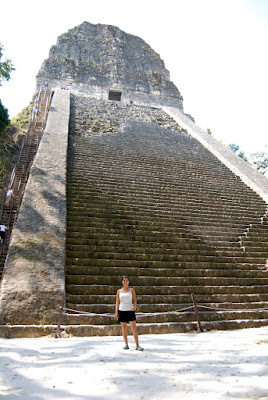Tikal, which means a “place of whispers,” is the largest and most impressive ancient city of the Mayan Civilization. Part of Guatemala’s 222 square mile
Parque Nacional Tikal, this Mayan ceremonial city sits on lowlands surrounded by the virgin rainforest with thousands of plant species including the gigantic ceiba tree, which is a sacred tree for the Mayans (copal incense is made from this tree for the ceremonies, the sanctity of it reminds me of the “sacred tree” in the movie
Avatar).
 |
| Ceiba tree at Tikal |
 |
| Foot of the Ceiba Tree (huge) |
Thousands of structures have been uncovered while thousands still remain underground hidden in the lush jungle. One of the thirteen most powerful energy vortexes on the planet, it continues to awe visitors from all over the world.
The precision and mathematical genius with which these were made rivals the Egyptian pyramids. Built as early as the 4th century, on an average the area gets over 500 earth tremors a year, but the structures remain earthquake-resistant. Constructed with limestone using only stone tools these structures mapped out the Earth’s revolution around the sun (365.24 -- more accurate than the western calendar), recorded the orbital cycles of many other planets, and predicted when the earth and sun would align with the center of the Milky Way (an event that happens every 28,500 years and is scheduled to occur in 2012). All of this along other critical information is encoded into the buildings, calculated without using any modern instruments.
 |
| In front of one of the pyramids in Tikal |
There are several main temples, the guide explains. “Temple one was to open the chakras; Temple two was to “cheat death” (if you had not figured out your life purpose yet, you could go there and fast and pray to be given more time); Temple three was to open the third eye, to see the future; Temple four was for flowing with the harmony of the universe and finding the balance (it’s aligned with Venus and Jupiter).”
Numerous books are written about the magnitude of Tikal but it still remains a mystery as to why the Mayans abandoned the city about 500 - 800 years after they built it. Popular theories include: global warming; droughts; volcanic eruptions in Asia; they simply left based on the guidance of their calendar and after encoding all their knowledge into the pyramids they resorted to living simpler lives in the remote jungles; or they evolved into higher consciousness and “disappeared”.
In any case, there’s much to learn from the footprints of these indigenous ancestors of humanity. Scientists have barely begun to scratch the surface of this vast storehouse of archaeological information and spiritual understanding.
 |
| Sacred gathering area for the Mayans at Tikal |




That's quite fascinating! Thanks for the fantastic photos and stories. It's a real treat for the rest of us armchair explorers who are glued to our computer screens. :)
ReplyDelete